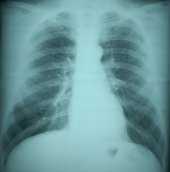CHEST RADIOGRAPHY

Evaluating Occupational Lung Disorders
The purpose of this NIOSH Safety and Health Topic Page is to provide information about radiographic classification of pneumoconioses and certain other occupational respiratory diseases. Radiographic classification issues, such as its history and development; how it relates to medical diagnosis, research, worker monitoring, government programs, and contested proceedings; best practices for those different settings; and how to become a NIOSH B Reader, are included. Throughout these pages, it is assumed that the radiographic classification is being undertaken using the International Labour Office (ILO) International Classification of Radiographs of Pneumoconioses.
NIOSH has developed guidance for radiographic classification applicable to various settings in Recommended Practices for Reliable Classification of Chest Radiographs by B Readers.
The transition from film screen to digital radiography in medicine has had important ramifications for the radiographic classification of pneumoconioses. NIOSH has developed information and tools to aid in this transition.
Reliability of Classifications
Settings employing radiographic classifications include worker medical monitoring, epidemiologic research, government programs, and privately contested proceedings typically involving compensation. In each of these, an important objective is to obtain information having appropriate reliability for the setting. In this, the need for reliability must be balanced against the various social and monetary costs involved.
Apart from using appropriate methods for image collection and viewing and a dedication to ethical classification practices, attention to reader competency and radiographic classification practices is necessary to obtain valid and reliable classifications. Proper reader training and assessment, such as that supplied by the NIOSH B Reader Program, ensures that readers have the appropriate knowledge and skills. Appropriate radiographic classification methods tailored to the specific setting will limit problems of bias and excessive variation that can otherwise arise.
Reliability implies both accuracy and precision. Accuracy denotes the ability for a measurement to reflect the true degree of underlying abnormality. Precision reflects the extent to which a measurement is consistent across repeated determinations. They are independent concepts: there can be precision without accuracy and accuracy without precision. Approaches exist to optimize the accuracy and precision of radiographic classification, and are detailed elsewhere on this web site (see Issues in Classification of Chest Radiographs ).
In all applications of the ILO radiographic classification for pneumoconioses it is important to remember that the chest radiograph findings alone are insufficient for the diagnosis of pneumoconiosis. Other data, such as the medical and occupational history, the physical examination, additional types of chest imaging, various laboratory tests, and biopsy results should also be considered.
In the associated topic pages, information is provided in detail on ensuring reader competency ( NIOSH B Reader Program ) and on principles of radiographic classification methods. In this, attention is drawn to the information presented on issues in radiographic classification , which discusses accuracy, precision, and reader variability. B Readers and those considering becoming a B Reader should examine the page on ethics for B Readers .
This material is critical reading for those involved in radiographic classification. Application of the methodological information presented here, coupled with use of NIOSH B Readers (or readers otherwise trained and assessed to the same, high standard), should lead to classifications having accuracy and precision appropriate for the intended setting.
Resources
-
NIOSH B Readers
- B Reader Program
- B Reader Information for Medical Professionals
- Ethical Considerations for B Readers CHEST RADIOGRAPHY
- NIOSH B Reader List
- NIOSH B Reader Study Syllabus
- NIOSH B Reader Study Sites
- Digital Chest Radiography / NIOSH BViewer
-
Radiographic Classification Methods
- ILO Classification
- Issues in Classification of Chest Radiographs
- Recommended Practices for Reliable Classification of Chest Radiographs by B Readers
- Resources
- Page last reviewed: May 24, 2011
- Page last updated: May 24, 2011
- Content source:
- National Institute for Occupational Safety and Health Respiratory Health Division


 ShareCompartir
ShareCompartir